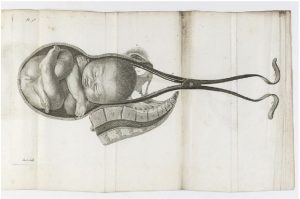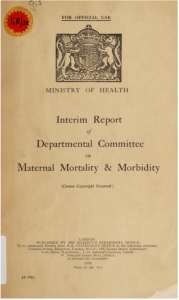The Inept Mother: How Medicalized Birth Neglects Mothers
Updated
“We need to imagine a world in which every woman is the presiding genius of her own body”
—Adrienne Rich, Of Woman Born
In the U.S., 98 percent of births happen in hospitals where they have become medicalized like a sickness—something wild to be regulated—birthing suits abut trauma units and surgical theatres, sterile systems created to prevent infection and death. But birth is messy yet transcendent and, as put by Adrienne Rich in Of Woman Born, “the one unifying, incontrovertible experience shared by all women and men is that months-long period we spent unfolding inside a woman’s body.” We are all held in our mothers’ wombs, soothed by heartbeats and vessel whooshes, protected from the muffled chaos of the outside world. Unfortunately, this unifying, sacred event has been appropriated by a medical system, which takes agency from mothers[1] and causes avoidable trauma.
Medicalization of Birth Strips Mothers of Agency
Medicalization is defined by Inhorn (2008) as a “biomedical tendency to pathologize otherwise normal bodily processes and states.” When pregnancy is medicalized, “it is described in medical terminology, treated in medical institutions, and people affected by it are regarded as patients” (Parry, 2008). This changes not only the physicality of the event but also how it is managed, viewed, and politicized. A once natural, woman-centered event, often happening at home or in a safe space, now “conceptualized as a dangerous time wherein a woman and her fetus are at risk and in need of constant medical monitoring and intervention” (Parry, 2008). This transforms mothers and their babies into patients who are treated universally, where “management of risk to the fetus has become the primary focus of medical intervention” (Al-Gailani, S. & Davis, A., 2014). This fetocentric viewpoint, in which the medical and social discourse conceptualizes pregnancy and birth as an unsafe time (Parry, 2008), means every care decision is rooted in fear of the worst-case to the infant, often neglecting the mother and causing unnecessary harm. Although there are real and urgent situations that require birth to be performed within the structure of the medical system, this does not mean that all births should be treated through this lens.
The medicalization of birth began in the early twentieth century. With the increasing need for an industrial labor force and military power, pregnant women and their babies suddenly became medically and politically important (Al-Gailani and Davis, 2014). With a new focus on antenatal care, women were viewed as incapable of making sound decisions during their pregnancy and required the supervision of a doctor (Oakley, 1986). The attitude towards pregnant women is evident in the 1930 Ministry of Health Report, which states that “the patient herself is often her own worst enemy, whether from ignorance or apathy, ill-health or prejudice, etc., and until she is able and willing to co-operate with doctor and nurse, attempts to assist her can never be fully effective” (pp. 39, emphasis mine). The language suggests that if a pregnant woman has her own ideas about her pregnancy and birth, then she is not “co-operating” with her provider. This frames pregnant women as incompetent and implies they should submit to what the provider deems necessary, irrespective of their desires or any evidence to the contrary.
Medicalized Birth Increases Intervention and Risk
The posture that birthing women are inept of their own bodies is still evident in hospital policy that routinely intervenes in physiologic birth. According to the International Childbirth Education Association (2016), the definition of physiologic birth is “a birth where the baby is birthed vaginally following a labor which has not been modified by medical interventions.” As described by Jansen et al. (2013), interventions, which are commonly used practices that can interfere with physiologic birth, can include “bed rest/recumbent position, electronic fetal monitoring (EFM), limited oral intake during labor, frequent vaginal exams, inductions/augmentations, amniotomy, regional anesthesia, catheterization, ineffective pushing, episiotomy, instrumental vaginal birth, and cesarean surgery.” As an example of a seemingly harmless intervention that disrupts the mother’s genius of her own body, Evidence Based Birth reports that in hospitals, 68 percent of U.S. women birth on their backs, and another 23 percent birth in a sitting-reclined position, regardless of data that shows that upright positions “allow a higher coccyx movement and lower widening of the pubic symphysis,” which facilitate a physiologic birth (Borges et al., 2021). With more freedom to move around, most home birthers innately choose an upright or side-laying position to birth, so why do over 90 percent of women give birth reclined in hospital beds? Evidence Based Birth explains that hospital providers usually only have training in, and rotations that only observe, back-laying or sitting-reclined positions, and so “they may not feel that they can handle unexpected emergencies when the birthing person is in an upright position” (Dekker, 2022). This putsthe medical provider’s comfort over the needs of the birthing mother, regardless of evidence that this may make birth more difficult, including prolonging labor, decreasing blood flow, escalating pain, and resulting in an increased risk of instrumental births and c-sections (Jansen et al., 2013). Unfortunately, this is just one example of how medicalized birth usurps Rich’s feminist ideal that “every woman is the presiding genius of her own body.”

The way that women are viewed during pregnancy impacts their care, their emotional and psychological wellbeing, and the risks a medical system is willing to inflict upon them. In The Captured Womb: A History of the Medical Care of Pregnant Women, Ann Oakley explains the history of how women came to be viewed as incapable receptacles of children: “The wombs of women—whether already pregnant or not—are containers to be captured by the ideologies and practices of those who, to put it simply, do not believe that women are able to take care of themselves.” This perception that women are unable to care for themselves during childbirth or pregnancy affects how they are treated. Founder of Human Rights in Childbirth, Hermine Hayes-Klein, says in a Quartz interview: “Underneath the idea that childbirth is somehow complicated or different compared to other kinds of informed consent is the idea that somehow because a woman is pregnant, she has less authority over her body than other people.” It is almost as if because there is a life inside them, mothers become incapable of making the best, informed decisions for their own bodies and babies, disregarding any heightened maternal intuition and innate protectiveness that they may experience. Sadly, mothers are often not given true informed consent because they are simply not trusted to make the right decisions.
As much as a third of women experience trauma during childbirth, and their perceptions of trauma overwhelmingly indicate it is provider-induced, particularly due to loss of control in decision-making and/or an unsupportive provider relationship. One study in BMC Pregnancy and Childbirth summarizes the traumas from “prioritizing the care provider’s agenda” to “abusive and violent” actions from providers—either psychological, such as feeling manipulated into an intervention by threatening the life of the baby, or physical, as being tethered to the bed or enduring forced episiotomies or vaginal exams during labor (Reed, Sharman & Inglis, 2017). Many women are left violated and feeling out of control after their birthing experience. While not all complications result in trauma, birth trauma can happen even in seemingly normal births (Sun et al., 2023), which is why medical communities need to re-evaluate perceptions of birthing mothers and policies of universal risk management and to see mothers as individuals capable of making informed choices for their own safety and that of their children.
How mothers are viewed has impacts far beyond the delivery room—it is the inception of every informed consent decision for their children and the apex of vaccination disclosure. This is reflective even in language when many people describe birth as a delivery—the doctor becomes the subject of the sentence, while the mother is relegated to an indirect object:
the doctor delivers the baby to (or for) the mother.
The baby is delivered by the doctor, not birthed by the mother. Once the act of birthing is removed from the mother, it becomes something being done to her rather than her own sacred experience. You can see how easy it is to shift from the mother as the expert to medical professionals, who are trained to look at patterns in all births and all children, but not just one.
References
Al-Gailani, S., & Davis, A. (2014). Introduction to “Transforming Pregnancy since
1900.” Studies in History and Philosophy of Science Part C: Studies in History and
Philosophy of Biological and Biomedical Sciences.
https://doi.org/10.1016/j.shpsc.2014.07.001
Blakemore, E. (2023, May 12). Progress on reducing infant and maternal deaths has stalled,
WHO warns. Washington Post.
https://www.washingtonpost.com/health/2023/05/14/gloabal-infant-maternal-mortality/
Borges, M., Moura, R., Oliveira, D., Parente, M., Mascarenhas, T., & Natal, R. (2021). Effect of
the birthing position on its evolution from a biomechanical point of view. Computer
Methods and Programs in Biomedicine, 200, 105921.
https://doi.org/10.1016/j.cmpb.2020.105921
Division of Vital Statistics (2022). Maternal mortality rates in the United States, 2020. National
Center for Health Statistics, Centers for Disease Control and Prevention.
DOI: https://dx.doi.org/10.15620/cdc:113967external icon.
Grant, R. (2022, July 20). “Assault and battery” in the delivery room: The disturbing trend of
obstetric violence. Quartz. https://qz.com/1177627/assault-and-battery-in-the-
delivery-room-the-disturbing-trend-of-obstetric-violence
Goodarzi, B., Walker, A., Holten, L., Schoonmade, L., Teunissen, P., Schellevis, F., & de Jonge,
- (2020). Towards a better understanding of risk selection in maternal and newborn
care: A systematic scoping review. PLOS ONE, 15(6).
https://doi.org/10.1371/journal.pone.0234252
Hollander, M., Van Hastenberg, E., Van Dillen, J., Van Pampus, M. G., De Miranda, E., &
Stramrood, C. a. I. (2017). Preventing traumatic childbirth experiences: 2192 women’s
perceptions and views. Archives of Women’s Mental Health, 20(4), 515–
- https://doi.org/10.1007/s00737-017-0729-6
Hoyert, D.L. (2023). Maternal Mortality Rates in the United States, 2021. National Center for
Health Statistics, Centers for Disease Control and Prevention. https://www.cdc.gov/nchs/data/hestat/maternal-mortality/2021/maternal-mortality-rates-2021.pdf
Inhorn, M.C. (2008), Defining Women’s Health: A Dozen Messages from More than 150
Ethnographies. Medical Anthropology Quarterly, 20: 345-378.
https://doi.org/10.1525/maq.2006.20.3.345
Jansen, L. E., Gibson, M. I., Bowles, B. C., & Leach, J. (2013). First Do No Harm: Interventions
During Childbirth. Journal of Perinatal Education, 22(2), 83–
- https://doi.org/10.1891/1058-1243.22.2.83
MacDorman, M.F., Barnard-Mayers, R. & Declercq, E. (2022) United States community births
increased by 20% from 2019 to 2020. Birth, 49 (2), 559-568.
https://doi.org/10.1111/birt.12627
Maternal Mortality and Maternity Care in the United States Compared to 10 Other Developed
Countries. (2020). www.commonwealthfund.org. https://doi.org/10.26099/411v-9255
National Center for Health Statistics (2022). National Vital Statistics Reports: Births: Final data
for 2020, 70(17), Centers for Disease Control, 1-50.
https://www.cdc.gov/nchs/data/nvsr/nvsr70/nvsr70-17.pdf
Negrini R., da Silva Ferreira R.D., Guimarães D.Z. (2021) Value-based care in obstetrics:
comparison between vaginal birth and caesarean section. BMC Pregnancy and
Childbirth, 21(1). https://doi.org/10.1186/s12884-021-03798-2
Oakley, Anne. (1986). The Captured Womb: A History of the Medical Care of Pregnant Women.
2nd Ed. Oxford and New York: Blackwell. Print.
Parry, D.C. (2008) “We Wanted a Birth Experience, not a Medical Experience”: Exploring
Canadian Women’s Use of Midwifery. Health Care for Women International, 29
(8), 784-806, https://doi.org/10.1080/07399330802269451
Reed, R., Sharman, R., and Inglis C. (2017) Women’s descriptions of childbirth trauma relating
to care provider actions and interactions. BMC Pregnancy Childbirth. 17(1).
https://doi.org/10.1186/s12884-016-1197-0
Rich, A. (1995). Of Woman Born: Motherhood as Experience and Institution. 2nd Ed.
New York and London: Norton. Print.
Sun, X., Fan, X., Cong, S., Wang, R., Sha, L., Xie, H., Han, J., Zhu, Z., & Zhang, A. (2023).
Psychological birth trauma: A concept analysis. Frontiers in
Psychology, 13. https://doi.org/10.3389/fpsyg.2022.1065612
[1] For the sake of clarity and consistency, “mothers” in this discussion refers to biological females who are pregnant, birthing or have birthed babies.








